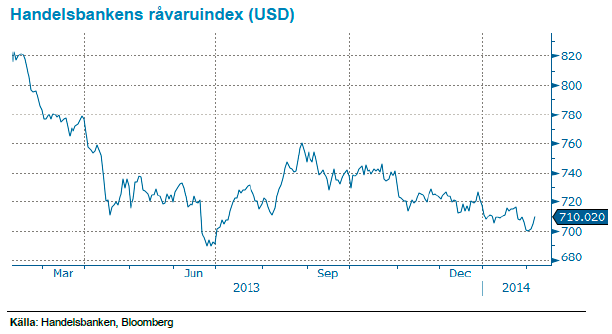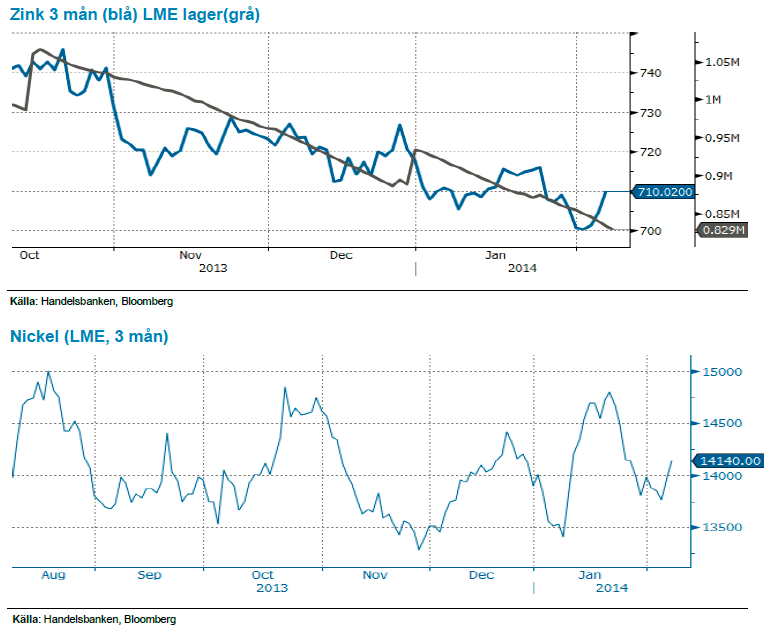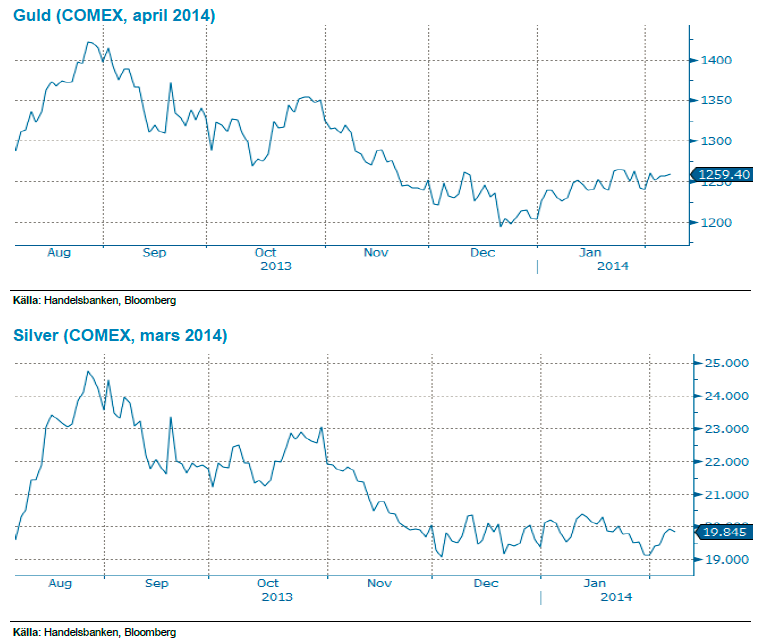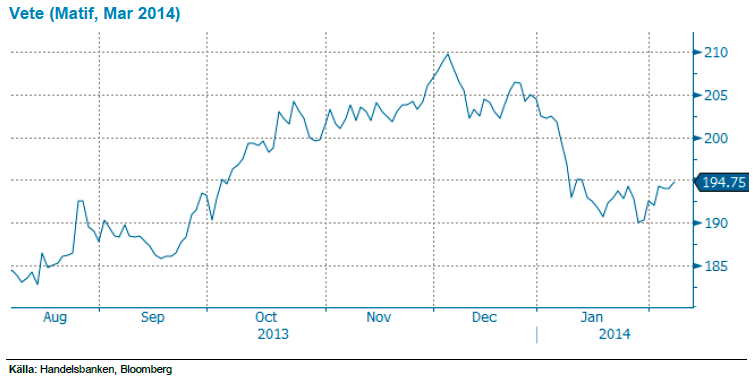Analys
SHB Råvarubrevet 7 februari 2014

 Råvaror allmänt: Oron tilltar
Råvaror allmänt: Oron tilltar
De senaste veckornas tumultartade utveckling i utvecklingsekonomierna har denna vecka spetsats till av att USA:s inköpschefsindex, ISM, föll dramatiskt i januari. Även fredagens non-farm payrolls överraskade negativt med 113 000 nya jobb mot väntade 180 000. Tillsammans med Kinas avmattning hjälper det föga att data i Europa har fortsatt bra. Investerare har helt plötsligt fått mycket ny oro att fundera över.
Endast tre gånger sedan 1990 har ISM fallit med mer än 5 enheter (5,2 i januari), vid varje tillfälle (2001, 2008, 2011) har ISM rättvist förutspått en inbromsning i konjunkturen. Det återstår att se hur februarisiffran kommer ut i mars före vi vet hur det blir denna gång. Om detta är startskottet på en ny besvikelse för återhämtningen kommer snart Fed under luppen. Vägen dit kantas dock av fallande marknader. Senaste åren har visat att råvaror också upplevt fallande priser när risktillgångar handlats ner.
Även om den kinesiska utvecklingen behöver lite tid efter nyårsfirandet för att dömas tror vi att uppsidan i drakens revir är liten. Tillväxtmålet för 2014 ska annonseras i mars men redan har 9 av de 22 provinserna annonserat lägre mål än under 2013. Tillsammans med de finansiella riskerna som nyligen blossat upp lägger de tillväxtkostande reformbehoven locket på för starkare efterfrågan på råvaror.
Basmetaller: Uppgångar, trots svagt Kina
Kina fortsätter att leverera svag data, inköpschefsindex för både tjänste- och tillverkningsindustrin föll under januari från föregående månad, i linje med vad marknaden förväntat sig. Trots svag data från både Kina och USA har metallerna klättrat uppåt under veckan. Zink sticker ut med sina 2,2 % medan övriga ligger runt procenten.
Japans största zinkproducent, Mitsui Mining & Smelting CO., höjer sina priser med 70 % för internationella köpare på grund av ökad efterfrågan från Kina. Globala produktionen väntas stramas åt under 2014 vilket ger stöd till priset. Zinklager på LME har fallit drastiskt under hösten och fortsätter att falla även efter årsskiftet, ned 11 % YTD.
Nickelpriset stöds fortsatt av exportförbudet i Indonesien och är den metall vi tror mest på. I övrigt håller vi en neutral vy för basmetallssektorn där vi ser uppsidan som begränsad då Kinas efterfrågan på metallen inte räcker till.
Låga prisnivåer, exportstopp av oförädlad nickelmalm från Indonesien och det faktum att 40 % av gruvorna går med förlust på dagens prisnivå. Vi tror på: LONG NICKEL H
Ädelmetaller: Emerging markets oro ger stöd
Den gångna veckan har präglats av fortsatt osäkerhet runt emerging markets, men både börser och valutor har återhämtat sig ganska bra. Trots detta har guldet – och i än högre grad ”lillebrorsan” silvret – stärkt sig. Guldet har i skrivande stund stärkts med 1,5 procent, och silver med nära 4 procent. Även platina och palladium har stigit, så hela ädelmetallsektorn har presterat bra – trots att riskaptiten återhämtat sig under veckan.
Även flödet till ETF-marknaden (för guld) är lätt positivt. Vi ser allt det som – om än litet – tecken på att vår nyligen påtagna positiva syn på ädelmetallsektorn. Vi tror alltjämt att konsensus runt guldet nu är negativt, och därmed positioneringen, och ser vi förnyad oro kring emerging markets så finns god potential för prisstegringar på samtliga ädelmetaller.
Efter en lång tid av negativ vy för guldet har vi bytt fot och tror på stigande pris. Vi tror på: LONG GULD H
Energi: Strejk vid oljeterminaler i Frankrike
Oljemarknaden stärks marginellt under veckan där en svagare dollar, strejk vid oljeterminaler i Frankrike samt en något stramare marknad för Nordsjöolja är några bidragande faktorer. Veckans amerikanska lagersiffror (se nedan) planar ut något för både råolja och bensin men heating oil faller i samband med den stränga kylan i Nordamerika.
I övrigt har det varit mest fokus på gasmarknaden som stiger väldigt kraftigt då kylan ser ut att bita sig fast under resten av februari. Brentoljan handlas i stort sett oförändrat över de senaste tre åren, i snitt 110.01 år 2011 och 111.68 år 2012 samt 108.70 år 2013, och vi har svårt att se vad som skall driva den ur detta intervall. Vår vy står därför fast, nivåer kring 106 är köpvärda med tanke på en ständigt närvarande oro kring MENA:s oljeproducerande länder. Däremot får man se potentialen på uppsidan som begränsad till en ca 4-5 dollar eftersom marknaden är i bra balans, USA producerar på höga nivåer samtidigt som utbudssituationen i Libyen ser ut att förbättras ytterligare.
För elen öppnade veckan starkt för de korta kontrakten, för att sedan backa tillbaka efter blötare prognoser.
Vintern verkar dröja och prognoserna visar på fortsatt milt väder med plusgrader och en nederbörd om 6,5 TWh väntas. Veckans snackis är utsläppsrätterna som haft en fantastisk utveckling och som stigit ytterligare 20 procent på bara en vecka (40 procent senaste månaden). Igår torsdag röstade man äntligen ja till att korta ner processen på backloading, som innebär att man drar tillbaka 400 miljoner rätter redan i år. Vi seren begränsad risk på uppsidan för utsläppsrätterna då det nu i huvudsak återstår ett godkännande av processen. Det milda vädret fortsätter att hålla priserna på både kol och gas nere. Kolet finner stöd efter att världens största kolexporthamn Richards Bay haft svårt att få ut tonnage då man dragits med problem kring elförsörjning hela januari. Detta förväntas vara åtgärdat under veckan som kommer.
Vi tror att det kommer ges möjligheter till god avkastning i denna range-baserade handel där oljan är köpvärd var gång den kommer ned på lägre nivåer. Vi tror på: LONG OLJA H
Livsmedel: Risk för utvintring är inte över
Priset på vete har gått upp under veckan dels på grund av att en del av USA:s höstveteregioner har upplevt kallt väder vilket skapat viss oro för utvintring. I mitten av nästa vecka väntas dock varmare väder igen. Nederbörd önskas innan grödan kommer ur vintervilan då stora delar är relativt torra. EU är milt och ganska blött, torrare i öst, och utan oro för grödorna som uppges vara i gott skick.
Rysslands jordbruksminister meddelade i veckan att på 95,5 procent av den höstsådda arealen är grödorna i gott eller i tillfredställande skick. Fina grödor alltså men glöm inte att arealen är omkring 10 procent mindre än året innan som följd av dåligt väder vid tid för sådd – vilket spås kunna kompenseras delvis av en ökad vårsådd. Ukraina har blivit lite varmare igen och även fått lite mer snö och risken för eventuell utvintring bedöms som liten. Det finns gott om vete (och annan spannmål) att tillgå i världen, dock försvåras tillgången av ganska stora logistikproblem – inte minst i Kanada som har svårt att få tågvagnar och andra transportsystem att klara av den stora skörden. Logistikproblem och fortfarande viss oro för utvintring begränsar för tillfället möjligheten till fallande priser. De grödor som såtts för skörd senare i år är dock i stort sett överallt i gott skick och vi tror det kommer krävas något lite mer allvarligt väderproblem för att inte trenden med fallande priser ska fortsätta. Vi håller en neutral vy för livsmedelssektorn där vi är neutrala till jordbruksprodukterna men positiva till de exotiska (apelsin juice, kakao, kaffe).
Vi ser allvarligt på bakteriesjukdomen som härjar i Florida och ökad spridning hotar att slå ut apelsinträden i år framöver. Vi tror på: BULL APELS X2 H
Handelsbankens råvaruindex
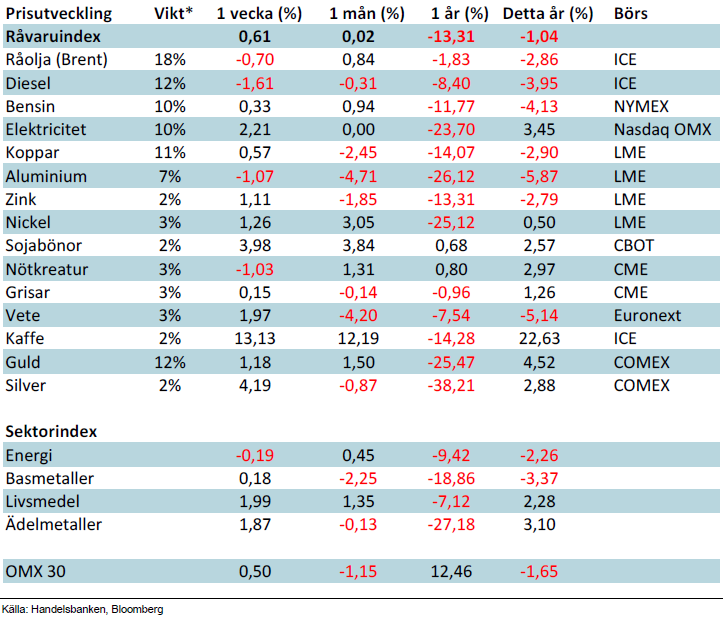
*Uppdaterade vikter från 29 november 2013
Handelsbankens råvaruindex består av de underliggande indexen för respektive råvara. Vikterna är bestämda till hälften från värdet av nordisk produktion (globala produktionen för sektorindex) och till hälften från likviditeten i terminskontrakten.
[box]SHB Råvarubrevet är producerat av Handelsbanken och publiceras i samarbete och med tillstånd på Råvarumarknaden.se[/box]
Ansvarsbegränsning
Detta material är producerat av Svenska Handelsbanken AB (publ) i fortsättningen kallad Handelsbanken. De som arbetar med innehållet är inte analytiker och materialet är inte oberoende investeringsanalys. Innehållet är uteslutande avsett för kunder i Sverige. Syftet är att ge en allmän information till Handelsbankens kunder och utgör inte ett personligt investeringsråd eller en personlig rekommendation. Informationen ska inte ensamt utgöra underlag för investeringsbeslut. Kunder bör inhämta råd från sina rådgivare och basera sina investeringsbeslut utifrån egen erfarenhet.
Informationen i materialet kan ändras och också avvika från de åsikter som uttrycks i oberoende investeringsanalyser från Handelsbanken. Informationen grundar sig på allmänt tillgänglig information och är hämtad från källor som bedöms som tillförlitliga, men riktigheten kan inte garanteras och informationen kan vara ofullständig eller nedkortad. Ingen del av förslaget får reproduceras eller distribueras till någon annan person utan att Handelsbanken dessförinnan lämnat sitt skriftliga medgivande. Handelsbanken ansvarar inte för att materialet används på ett sätt som strider mot förbudet mot vidarebefordran eller offentliggörs i strid med bankens regler.
Analys
The Mid-East anchor dragging crude oil lower

When it starts to move lower it moves rather quickly. Gaza, China, IEA. Brent crude is down 2.1% today to $62/b after having traded as high as $66.58/b last Thursday and above $70/b in late September. The sell-off follows the truce/peace in Gaze, a flareup in US-China trade and yet another bearish oil outlook from the IEA.

A lasting peace in Gaze could drive crude oil at sea to onshore stocks. A lasting peace in Gaza would probably calm down the Houthis and thus allow more normal shipments of crude oil to sail through the Suez Canal, the Red Sea and out through the Bab-el-Mandeb Strait. Crude oil at sea has risen from 48 mb in April to now 91 mb versus a pre-Covid normal of about 50-60 mb. The rise to 91 mb is probably the result of crude sailing around Africa to be shot to pieces by the Houthis. If sailings were to normalize through the Suez Canal, then it could free up some 40 mb in transit at sea moving onshore into stocks.
The US-China trade conflict is of course bearish for demand if it continues.
Bearish IEA yet again. Getting closer to 2026. Credibility rises. We expect OPEC to cut end of 2025. The bearish monthly report from the IEA is what it is, but the closer we get to 2026, the more likely the IEA is of being ball-park right in its outlook. In its monthly report today the IEA estimates that the need for crude oil from OPEC in 2026 will be 25.4 mb/d versus production by the group in September of 29.1 mb/d. The group thus needs to do some serious cutting at the end of 2025 if it wants to keep the market balanced and avoid inventories from skyrocketing. Given that IEA is correct that is. We do however expect OPEC to implement cuts to avoid a large increase in inventories in Q1-26. The group will probably revert to cuts either at its early December meeting when they discuss production for January or in early January when they discuss production for February. The oil price will likely head yet lower until the group reverts to cuts.
Dubai: The Mid-East anchor dragging crude oil lower. Surplus emerging in Mid-East pricing. Crude oil prices held surprisingly strong all through the summer. A sign and a key source of that strength came from the strength in the front-end backwardation of the Dubai crude oil curve. It held out strong from mid-June and all until late September with an average 1-3mth time-spread premium of $1.8/b from mid-June to end of September. The 1-3mth time-spreads for Brent and WTI however were in steady deterioration from late June while their flat prices probably were held up by the strength coming from the Persian Gulf. Then in late September the strength in the Dubai curve suddenly collapsed. Since the start of October it has been weaker than both the Brent and the WTI curves. The Dubai 1-3mth time-spread now only stands at $0.25/b. The Middle East is now exporting more as it is producing more and also consuming less following elevated summer crude burn for power (Aircon) etc.
The only bear-element missing is a sudden and solid rise in OECD stocks. The only thing that is missing for the bear-case everyone have been waiting for is a solid, visible rise in OECD stocks in general and US oil stocks specifically. So watch out for US API indications tomorrow and official US oil inventories on Thursday.
No sign of any kind of fire-sale of oil from Saudi Arabia yet. To what we can see, Saudi Arabia is not at all struggling to sell its oil. It only lowered its Official Selling Prices (OSPs) to Asia marginally for November. A surplus market + Saudi determination to sell its oil to the market would normally lead to a sharp lowering of Saudi OSPs to Asia. Not yet at least and not for November.
The 5yr contract close to fixed at $68/b. Of importance with respect to how far down oil can/will go. When the oil market moves into a surplus then the spot price starts to trade in a large discount to the 5yr contract. Typically $10-15/b below the 5yr contract on average in bear-years (2009, 2015, 2016, 2020). But the 5yr contract is usually pulled lower as well thus making this approach a moving target. But the 5yr contract price has now been rock solidly been pegged to $68/b since 2022. And in the 2022 bull-year (Brent spot average $99/b), the 5yr contract only went to $72/b on average. If we assume that the same goes for the downside and that 2026 is a bear-year then the 5yr goes to $64/b while the spot is trading at a $10-15/b discount to that. That would imply an average spot price next year of $49-54/b. But that is if OPEC doesn’t revert to cuts and instead keeps production flowing. We think OPEC(+) will trim/cut production as needed into 2026 to prevent a huge build-up in global oil stocks and a crash in prices. But for now we are still heading lower. Into the $50ies/b.
Analys
More weakness and lower price levels ahead, but the world won’t drown in oil in 2026

Some rebound but not much. Brent crude rebounded 1.5% yesterday to $65.47/b. This morning it is inching 0.2% up to $65.6/b. The lowest close last week was on Thursday at $64.11/b.

The curve structure is almost as week as it was before the weekend. The rebound we now have gotten post the message from OPEC+ over the weekend is to a large degree a rebound along the curve rather than much strengthening at the front-end of the curve. That part of the curve structure is almost as weak as it was last Thursday.
We are still on a weakening path. The message from OPEC+ over the weekend was we are still on a weakening path with rising supply from the group. It is just not as rapidly weakening as was feared ahead of the weekend when a quota hike of 500 kb/d/mth for November was discussed.
The Brent curve is on its way to full contango with Brent dipping into the $50ies/b. Thus the ongoing weakening we have had in the crude curve since the start of the year, and especially since early June, will continue until the Brent crude oil forward curve is in full contango along with visibly rising US and OECD oil inventories. The front-month Brent contract will then flip down towards the $60/b-line and below into the $50ies/b.
At what point will OPEC+ turn to cuts? The big question then becomes: When will OPEC+ turn around to make some cuts? At what (price) point will they choose to stabilize the market? Because for sure they will. Higher oil inventories, some more shedding of drilling rigs in US shale and Brent into the 50ies somewhere is probably where the group will step in.
There is nothing we have seen from the group so far which indicates that they will close their eyes, let the world drown in oil and the oil price crash to $40/b or below.
The message from OPEC+ is also about balance and stability. The world won’t drown in oil in 2026. The message from the group as far as we manage to interpret it is twofold: 1) Taking back market share which requires a lower price for non-OPEC+ to back off a bit, and 2) Oil market stability and balance. It is not just about 1. Thus fretting about how we are all going to drown in oil in 2026 is totally off the mark by just focusing on point 1.
When to buy cal 2026? Before Christmas when Brent hits $55/b and before OPEC+ holds its last meeting of the year which is likely to be in early December.
Brent crude oil prices have rebounded a bit along the forward curve. Not much strengthening in the structure of the curve. The front-end backwardation is not much stronger today than on its weakest level so far this year which was on Thursday last week.
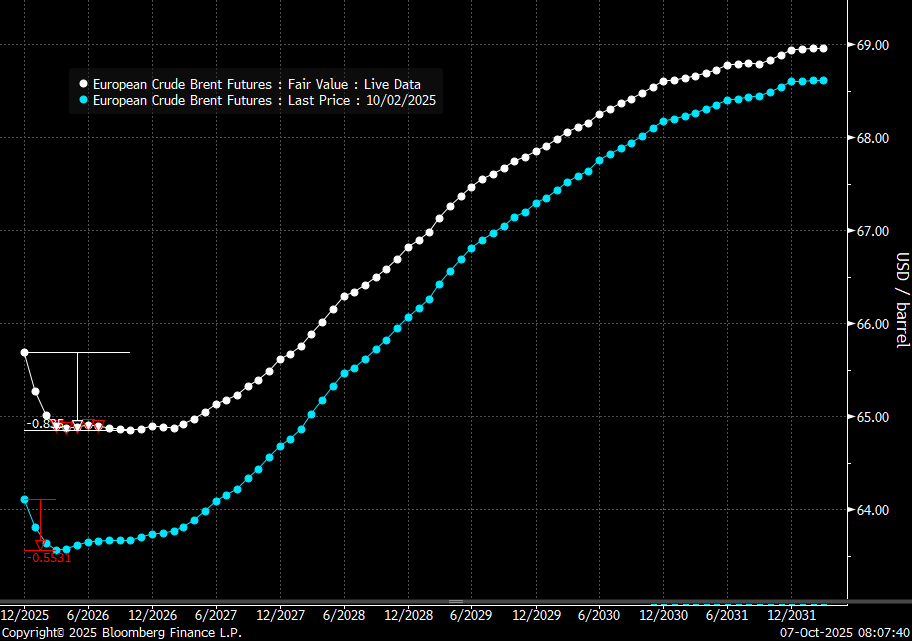
The front-end backwardation fell to its weakest level so far this year on Thursday last week. A slight pickup yesterday and today, but still very close to the weakest year to date. More oil from OPEC+ in the coming months and softer demand and rising inventories. We are heading for yet softer levels.

Analys
A sharp weakening at the core of the oil market: The Dubai curve

Down to the lowest since early May. Brent crude has fallen sharply the latest four days. It closed at USD 64.11/b yesterday which is the lowest since early May. It is staging a 1.3% rebound this morning along with gains in both equities and industrial metals with an added touch of support from a softer USD on top.

What stands out the most to us this week is the collapse in the Dubai one to three months time-spread.
Dubai is medium sour crude. OPEC+ is in general medium sour crude production. Asian refineries are predominantly designed to process medium sour crude. So Dubai is the real measure of the balance between OPEC+ holding back or not versus Asian oil demand for consumption and stock building.
A sharp weakening of the front-end of the Dubai curve. The front-end of the Dubai crude curve has been holding out very solidly throughout this summer while the front-end of the Brent and WTI curves have been steadily softening. But the strength in the Dubai curve in our view was carrying the crude oil market in general. A source of strength in the crude oil market. The core of the strength.
The now finally sharp decline of the front-end of the Dubai crude curve is thus a strong shift. Weakness in the Dubai crude marker is weakness in the core of the oil market. The core which has helped to hold the oil market elevated.
Facts supports the weakening. Add in facts of Iraq lifting production from Kurdistan through Turkey. Saudi Arabia lifting production to 10 mb/d in September (normal production level) and lifting exports as well as domestic demand for oil for power for air con is fading along with summer heat. Add also in counter seasonal rise in US crude and product stocks last week. US oil stocks usually decline by 1.3 mb/week this time of year. Last week they instead rose 6.4 mb/week (+7.2 mb if including SPR). Total US commercial oil stocks are now only 2.1 mb below the 2015-19 seasonal average. US oil stocks normally decline from now to Christmas. If they instead continue to rise, then it will be strongly counter seasonal rise and will create a very strong bearish pressure on oil prices.
Will OPEC+ lift its voluntary quotas by zero, 137 kb/d, 500 kb/d or 1.5 mb/d? On Sunday of course OPEC+ will decide on how much to unwind of the remaining 1.5 mb/d of voluntary quotas for November. Will it be 137 kb/d yet again as for October? Will it be 500 kb/d as was talked about earlier this week? Or will it be a full unwind in one go of 1.5 mb/d? We think most likely now it will be at least 500 kb/d and possibly a full unwind. We discussed this in a not earlier this week: ”500 kb/d of voluntary quotas in October. But a full unwind of 1.5 mb/d”
The strength in the front-end of the Dubai curve held out through summer while Brent and WTI curve structures weakened steadily. That core strength helped to keep flat crude oil prices elevated close to the 70-line. Now also the Dubai curve has given in.
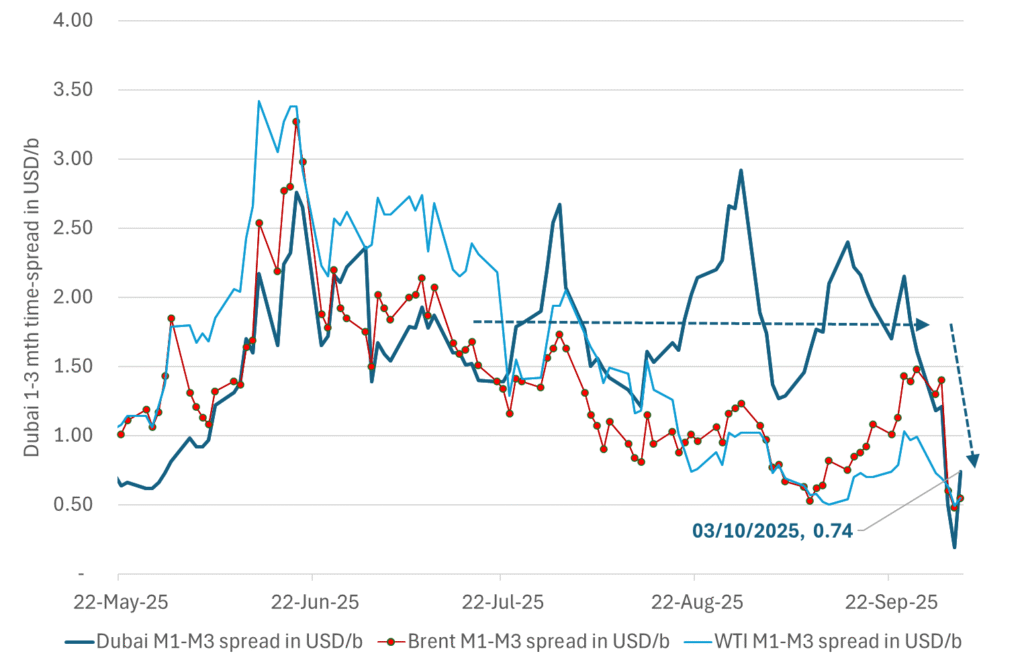
Brent crude oil forward curves
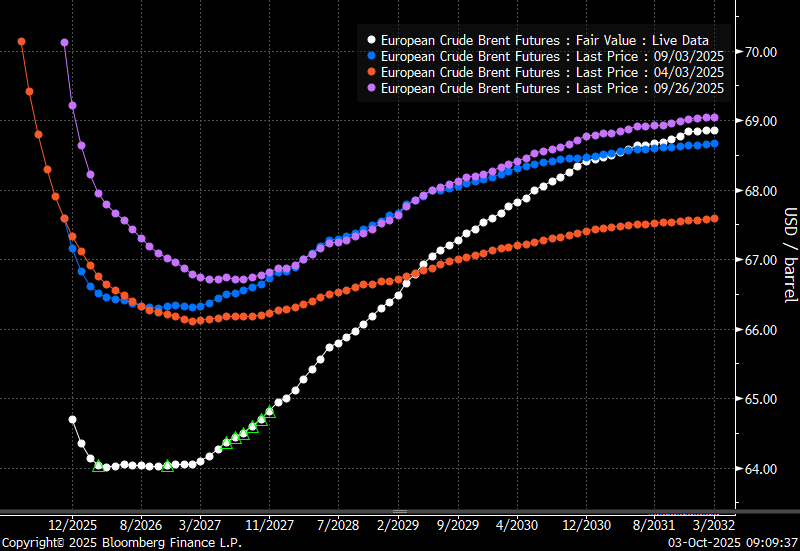
Total US commercial stocks now close to normal. Counter seasonal rise last week. Rest of year?
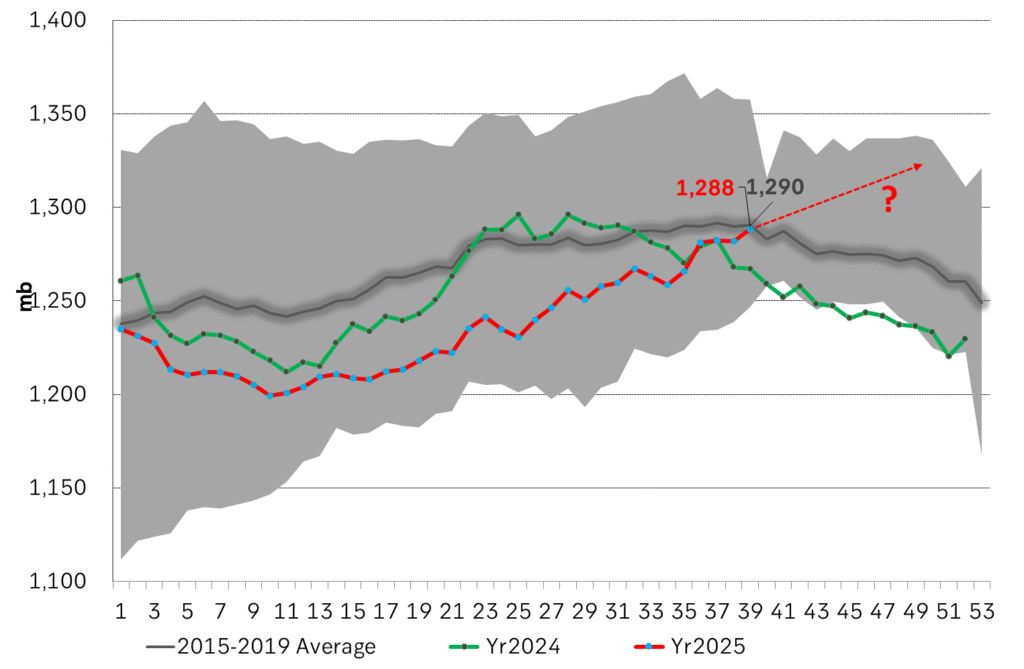
Total US crude and product stocks on a steady trend higher.
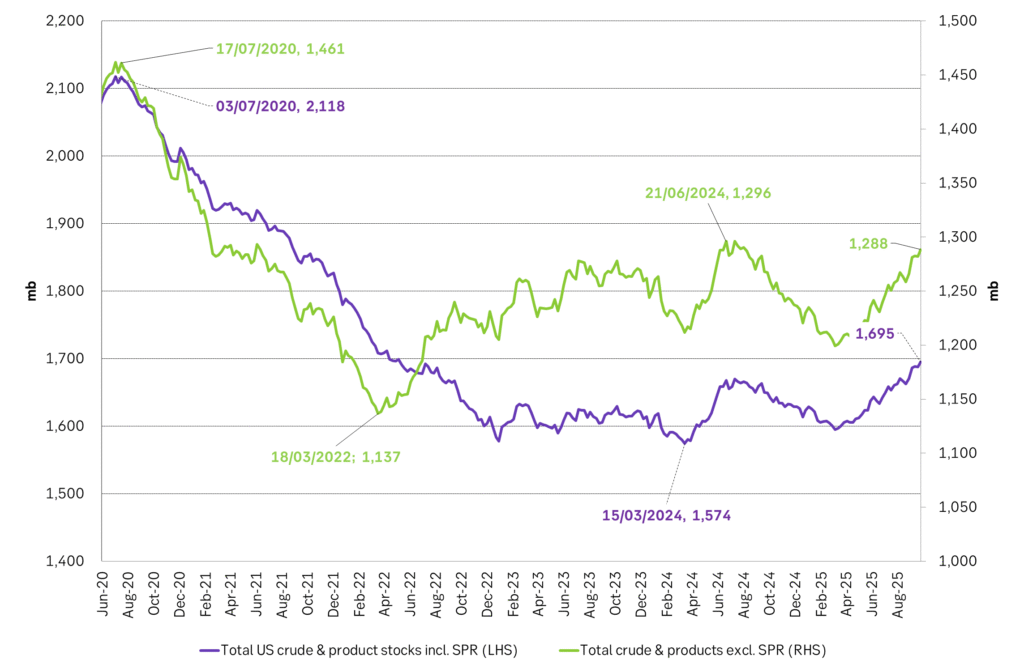
-

 Nyheter4 veckor sedan
Nyheter4 veckor sedanTyskland har så höga elpriser att företag inte har råd att använda elektricitet
-

 Nyheter3 veckor sedan
Nyheter3 veckor sedanOPEC+ missar produktionsmål, stöder oljepriserna
-

 Nyheter3 veckor sedan
Nyheter3 veckor sedanEtt samtal om guld, olja, fjärrvärme och förnybar energi
-

 Analys4 veckor sedan
Analys4 veckor sedanBrent crude ticks higher on tension, but market structure stays soft
-

 Nyheter2 veckor sedan
Nyheter2 veckor sedanGuld nära 4000 USD och silver 50 USD, därför kan de fortsätta stiga
-

 Analys3 veckor sedan
Analys3 veckor sedanAre Ukraine’s attacks on Russian energy infrastructure working?
-

 Nyheter2 veckor sedan
Nyheter2 veckor sedanBlykalla och amerikanska Oklo inleder ett samarbete
-

 Nyheter3 veckor sedan
Nyheter3 veckor sedanGuldpriset uppe på nya höjder, nu 3750 USD


